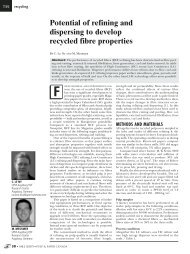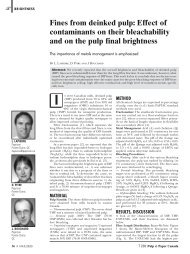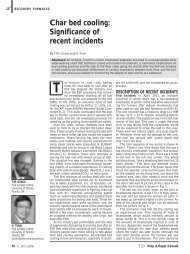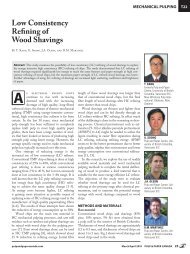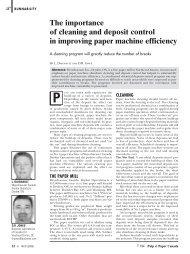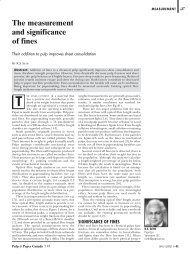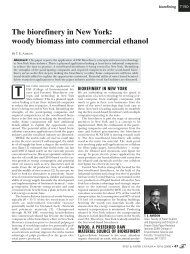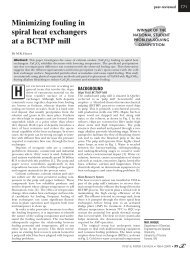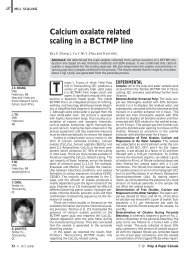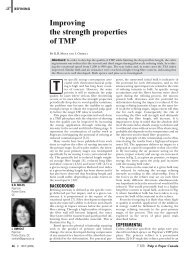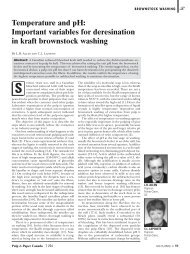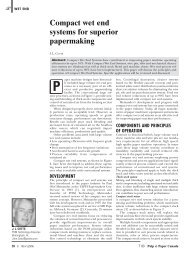Rate determining step and kinetics of oxygen delignification
Rate determining step and kinetics of oxygen delignification
Rate determining step and kinetics of oxygen delignification
Create successful ePaper yourself
Turn your PDF publications into a flip-book with our unique Google optimized e-Paper software.
T35<strong>oxygen</strong> <strong>delignification</strong>table Ii. Properties <strong>of</strong> CSTR <strong>oxygen</strong> delignified pulps (at 3.3g/l NaOH, 90°C <strong>and</strong>0.52MPa).Time Kappa Viscosity Cellulose, G Hemicellulose, H DP <strong>of</strong>(min) (ml/g) (g/g pulp) (g/g pulp) cellulose0 24.4 1189 0.714 0.142 656110 20.1 1079 0.732 0.139 572420 18.5 1033 0.734 0.142 543540 14.3 877 0.746 0.140 444560 12.7 828 0.750 0.138 4144180 7.6 592 0.763 0.135 2784table iII. Properties <strong>of</strong> Batch <strong>oxygen</strong> delignified pulps (3% NaOH, 90°C, 0.52MPa, 10% Cons.).Time Kappa Viscosity Cellulose, G Hemicellulose, H DP <strong>of</strong>(min) (ml/g) (g/g pulp) (g/g pulp) cellulose0 24.4 1189 0.714 0.142 656110 20.8 1058 0.723 0.139 567420 18.5 1011 0.723 0.138 539440 15.0 924 0.729 0.139 483160 13.5 898 0.736 0.140 4629180 10.1 829 0.736 0.141 4230Based on these results the cellulosedegradation was modeled by two contributions:one due to radicals produced byphenolic <strong>delignification</strong>, <strong>and</strong> the other dueto alkaline hydrolysis. The model can bedescribed as equation (17):dm ndK–––– = –k c–––– + k h[OH – ] (17)dt dtwhere k cis the rate constant for radical attack,<strong>and</strong> k his the alkaline hydrolysis rate constant.[OH – ] is the alkali concentration in g/L.Integration <strong>of</strong> equation (17) gives:m n= m 0+ k c(K – K 0) + k h[OH – ]t (18)Comparable results for the same brownstock pulp <strong>oxygen</strong> delignified in a batchreactor samples are given in Table 3. SinceNaOH is rapidly consumed during theinitial phase <strong>of</strong> <strong>oxygen</strong> <strong>delignification</strong> ina batch reactor, the influence <strong>of</strong> the termk h[OH – ]t in equation (18) may be neglectedfor t ≥ 20 minutes. This allows calculation<strong>of</strong> kc by fitting the batch reactor as3.60 x 10 -8 (moles/g pulp·kappa). Usingthis value in the analysis <strong>of</strong> the CSTR datagives a value for k h<strong>of</strong> 1.07 x 10 -9 (liter·molcellulose/g pulp·g NaOH·minute). Thesetwo values provide a good fit <strong>of</strong> the cellulosedegradation in the CSTR <strong>and</strong> batchreactor as can be seen in Figure 10.ConclusionsThe <strong>kinetics</strong> <strong>of</strong> <strong>oxygen</strong> <strong>delignification</strong> arefirst order in residual lignin content (HexAcorrected), <strong>and</strong> follow a Langmuir-typebehavior for adsorption <strong>of</strong> <strong>oxygen</strong> on theactive aromatic lignin sites. The reactionorder in NaOH <strong>of</strong> the <strong>kinetics</strong> implies thatthe rate <strong>determining</strong> <strong>step</strong> involves an acidiclignin active site with a pKa almost 2 unitshigher than that <strong>of</strong> phenol in lignin. Basedon these results it is proposed that thelignin active site is the 3 carbon <strong>of</strong> the aromaticring where <strong>oxygen</strong> reacts to form ahydroperoxide. The rate <strong>determining</strong> <strong>step</strong>is identified as the unimolecular decomposition<strong>of</strong> the formed hydroperoxide anion.The almost uniform presence <strong>of</strong> aromaticmethoxyl groups in residual lignin furthersupports the first order in lignin <strong>kinetics</strong>.Further supporting evidence is the closerelationship between <strong>delignification</strong> <strong>and</strong>demethoxylation. The significant reductionin phenolic group content <strong>of</strong> the ligninduring <strong>oxygen</strong> <strong>delignification</strong> is consistentwith the hypothesis that the rate <strong>determining</strong><strong>step</strong> <strong>of</strong> <strong>oxygen</strong> <strong>delignification</strong> is not adirect attack <strong>of</strong> <strong>oxygen</strong> on the dissociatedphenolic groups. The cellulose degradationduring <strong>oxygen</strong> <strong>delignification</strong> was modeledby two contributions: one due to radicalsproduced by phenolic <strong>delignification</strong>, <strong>and</strong>the other due to alkaline hydrolysis.AcknowledgementFinancial support by the TechnologyDevelopment Agency <strong>of</strong> Finl<strong>and</strong>(TEKES), Helsinki University <strong>of</strong> Technology<strong>and</strong> the Ober Chair is gratefullyacknowledged. The discussions with Dr.Raymond Fort Jr. at the University <strong>of</strong>Maine were essential for our underst<strong>and</strong>ing<strong>of</strong> the mechanism, <strong>and</strong> are greatlyappreciated.Literature:1. Edwards L. <strong>and</strong> Nordberg S-E. (1973) AlkalineDelignification Kinetics, a General Model Applied toOxygen Bleaching <strong>and</strong> Kraft Pulping, TAPPI, 56(11),108-1112. Teder A. <strong>and</strong> Olm L. (1981) Extended <strong>delignification</strong>by combination <strong>of</strong> modified kraft pulp <strong>and</strong> <strong>oxygen</strong>bleaching, Paperi Puu, 63(4a), 315-3263. Ljunggren, S.C.H <strong>and</strong> Johansson ,E.C. (1987)Reaction Kinetics <strong>of</strong> Lignin Structures during OxygenBleaching-Effects <strong>of</strong> Solvent, Oxygen Pressure <strong>and</strong>pH, In: International Oxygen Delignification Conference,Tappi Proceedings, 1254. Kovasin K., P. Uusitalo P., M. Viilo, (1987) Dimensioning<strong>of</strong> <strong>oxygen</strong> <strong>delignification</strong> reactors, InternationalOxygen Delignification Conference, June 7-12,San Diego, USA, pp. 223-2305. Johansson, E., Ljunggren, S., (1994) The Kinetics<strong>of</strong> Lignin Reaction During Oxygen Delignification,Part 4. The Reactivates <strong>of</strong> Different Lignin ModelCompounds <strong>and</strong> the Influence <strong>of</strong> Metal Ions on the<strong>Rate</strong> <strong>of</strong> Degradation, J. Wood Chem. Technol. 14(4),507-5256. Li, J. <strong>and</strong> Gellerstedt, G., (2002) Oxymercuration– Demercuration Kappa Number: an Accurate Estimation<strong>of</strong> the Lignin Content in Chemical Pulps, NordicPulp Paper Res. J. 17(4), 410-4147. Rööst, C., Lawoko, M., Gellerstedt, G. (2003) StructuralChanges in Residual Kraft Pulp Lignins. Effects<strong>of</strong> Kappa Number <strong>and</strong> Degree <strong>of</strong> Oxygen Delignification,Nordic Pulp Paper Res. J. 18(4), 395-3998. Ji Y. <strong>and</strong> van Heiningen A. (2007) A new CSTRfor Oxygen Delignification Mechanism <strong>and</strong> KineticsStudy, Pulp Paper Canada, 108(5), 38-429. Tenkanen, M.,G. Gellerstedt, T. Vuorinen, A.Teleman, M. Perttula, J. Li, <strong>and</strong> J. Buchert (1999)Determination <strong>of</strong> Hexenuronic Acid in S<strong>of</strong>twoodKraft Pulps by Three Different Methods, J. Pulp PaperSci. 25(9), 306-31110. Vuorinen, T. et al., (1999) Selective Hydrolysis <strong>of</strong>Hexenuronic Acid Groups <strong>and</strong> its Application in ECF<strong>and</strong> TCF Bleaching <strong>of</strong> Kraft Pulps, J. Pulp Paper Sci.25(5), 155-162.11. Ji, Y. (2007) Kinetics <strong>and</strong> Mechanism <strong>of</strong> OxygenDelignification, PhD thesis, University <strong>of</strong> Maine,Orono, USA12. Gartner, A., Gellerstedt G. <strong>and</strong> Tamminen T.(1999) Determination <strong>of</strong> Phenolic Hydroxyl Groupsin Residual Lignin using a Modified UV-Method.Nordic Pulp Paper Res. J. 14(2), 163-17013. Norgren, M., <strong>and</strong> Lindstrom B., (2000) Dissociation<strong>of</strong> Phenolic Groups in Kraft Lignin at ElevatedTemperatures Holzforschung, 54, 519-52714. Tromans D., (1998) Oxygen Solubility Modelingin Inorganic Solutions: Concentration, Temperature<strong>and</strong> Pressure Effects, Hydrometallurgy, (50), 279-29615. Ji, Y., Wheeler M. C. <strong>and</strong> van Heiningen A. (2007)Oxygen Delignification Kinetics: CSTR <strong>and</strong> BatchReactor Comparison, AIChE J. 53(10), 2681-268716. Vanska, E., (2007) Kinetics <strong>of</strong> Oxygen Delignificationin a Continuous Stirred Tank Reactor, M. Sc.Thesis, Helsinki University <strong>of</strong> Technology, Espoo,Finl<strong>and</strong>17. Van Heiningen, A., Ji, Y., Vänskä, E., (2008) New<strong>kinetics</strong> <strong>and</strong> mechanism <strong>of</strong> <strong>oxygen</strong> <strong>delignification</strong>:International Pulp Bleaching Conference, June 2-5,Quebec City, Canada. 91-9818. Chang H. <strong>and</strong> Gratzl J. S. (1980) Ring CleavageReactions <strong>of</strong> Lignin Models with Oxygen <strong>and</strong> Alkali,In. Chemistry <strong>of</strong> Delignification with Oxygen, Ozone<strong>and</strong> Peroxide, Uni Pub. Co. Ltd, Tokyo, Japan, pp.151-16319. Hausman, M.C., Elder, T.R. <strong>and</strong> Fort, R.C. Jr.(2003) How Do Phenoxyl Radicals Form During OxygenDelignification? 12 th International Symposium onWood <strong>and</strong> Chemistry (ISWPC), June 9-12, Madison,WI, USA, Poster presentations pp. 59-6220. McDonough, T. J. (1996) Chapter IV 1: OxygenDelignification, in Pulp Bleaching – Principles <strong>and</strong>34 March 2009 Pulp & Paper Canada pulp<strong>and</strong>papercanada.com



